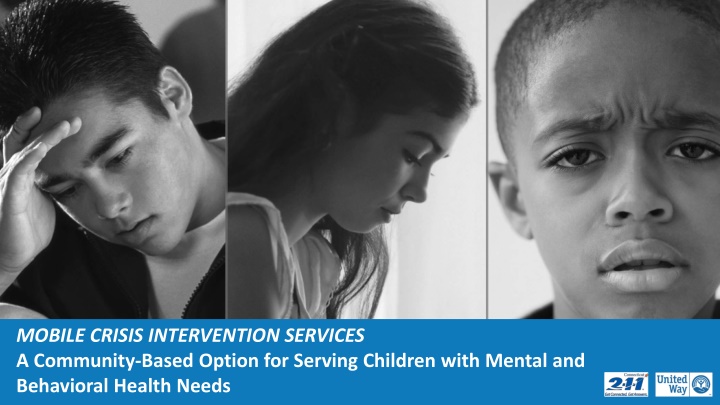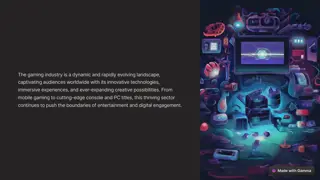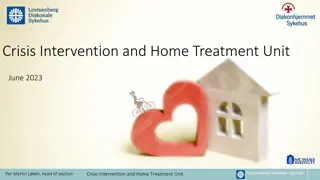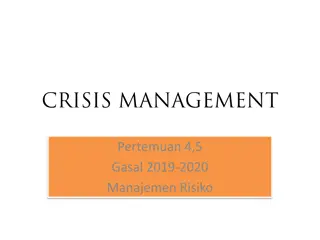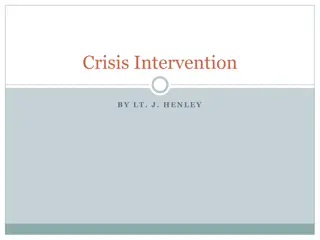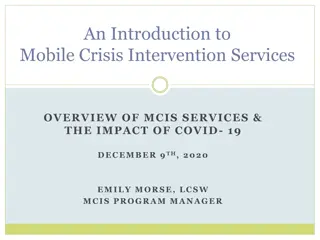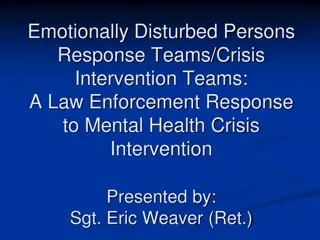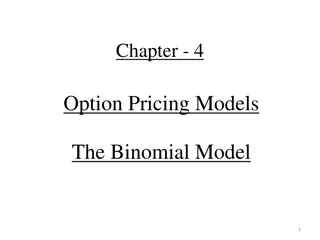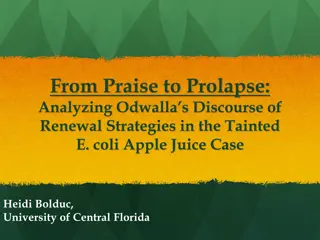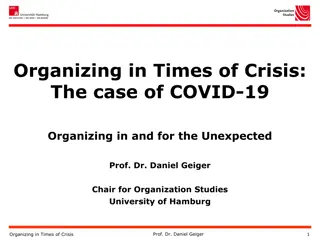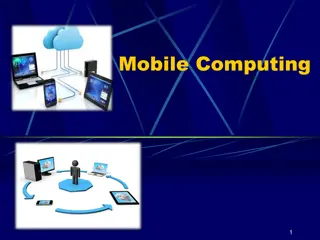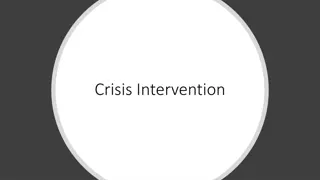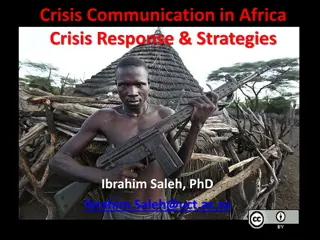Mobile Crisis Intervention Services: Community-Based Option for Children with Mental and Behavioral Health Needs
Mobile Crisis Intervention Services (formerly Emergency Mobile Psychiatric Services) provide rapid emergency crisis stabilization, short-term follow-up care, and connections to other services for children and adolescents experiencing mental or behavioral health crises. Available statewide in Connecticut, Mobile Crisis is accessible to children and youth aged 17 or younger, even if already receiving community-based mental health services. Services can be accessed by calling 2-1-1, and crisis interventions can take place in various settings including homes, schools, doctor's offices, and community locations.
Download Presentation

Please find below an Image/Link to download the presentation.
The content on the website is provided AS IS for your information and personal use only. It may not be sold, licensed, or shared on other websites without obtaining consent from the author.If you encounter any issues during the download, it is possible that the publisher has removed the file from their server.
You are allowed to download the files provided on this website for personal or commercial use, subject to the condition that they are used lawfully. All files are the property of their respective owners.
The content on the website is provided AS IS for your information and personal use only. It may not be sold, licensed, or shared on other websites without obtaining consent from the author.
E N D
Presentation Transcript
MOBILE CRISIS INTERVENTION SERVICES A Community-Based Option for Serving Children with Mental and Behavioral Health Needs Behavioral Health Needs MOBILE CRISIS INTERVENTION SERVICES A Community-Based Option for Serving Children with Mental and
What is Mobile Crisis Intervention Services (Mobile Crisis)? Mobile Crisis Intervention Services (Mobile Crisis), formerly Emergency Mobile Psychiatric Services EMPS, is the same service just with a new name. Mobile Crisis is a state-wide, community based and family supportive clinical intervention service for children & adolescents experiencing a behavioral or mental health crisis. Mobile Crisis provides rapid emergency crisis stabilization for children and their families as well as short-term follow-up care and connection to other services. Dial 2-1-1 Dial 2-1-1
Who Can Receive Mobile Crisis Services? Mobile Crisis is available to all Connecticut children and youth ages 17 or younger in a mental health or behavioral crisis (can serve 18 and older if still enrolled in high school). Mobile Crisis is available for children in crisis, even if they are already receiving community based mental/behavioral health services such as individual or family therapy, day treatment, etc. Anyone can call for Mobile Crisis services on behalf of a child or youth with a mental or behavioral health crisis. Dial 2-1-1 Dial 2-1-1
Where are Mobile Crisis Services Provided? Mobile Crisis comes to the child A child can receive Mobile Crisis services in: Their home At school At their doctor s office In the Emergency Department (ED) Any other community setting Residential Treatment Centers, Sub-Acute Units or Inpatient Units are not served by Mobile Crisis given their in-house clinical services. Dial 2-1-1 Dial 2-1-1
Where are Mobile Crisis Services Provided? There are six (6) Mobile Crisis service areas that cover the entire state. All Connecticut towns are covered. The six service providers and areas of the state they cover: Child and Family Guidance Center Southwest Area Clifford W. Beers Guidance Clinic New Haven Area Community Health Resources Central Area United Community and Family Services Eastern Area Wellmore Behavioral Health Western Area Wheeler Clinic Hartford Area Dial 2-1-1 Dial 2-1-1
What is a Crisis for Mobile Crisis Services? What constitutes a crisis for the child or family is defined by the caller, not by Mobile Crisis. Mobile Crisis does not have pre-determined criteria for what qualifies as a crisis. The Mobile Crisis team response (face to face contact, phone contact) is contingent on the child s specific situation and the time of the call. Mobile Crisis services are confidential Dial 2-1-1 Dial 2-1-1
Who Provides Mobile Crisis Services? Mobile Crisis services are provided by highly trained mental health professionals The Mobile Crisis staff are licensed or license eligible Clinical Psychologists, Clinical Social Workers, Marriage and Family Therapists, Professional Counselors, and Alcohol and Drug Counselors All Mobile Crisis clinical staff receive ongoing refresher training and are required to take 11 to 12 specific courses within their first year to support the skills needed to work with children and families Dial 2-1-1 Dial 2-1-1
Is There a Charge for Mobile Crisis Services? There is no out of pocket cost to parents for the Mobile Crisis Intervention Services. Mobile Crisis will request insurance information from parents to bill the insurance company; however, if the claim is denied or if there is a co-pay, there is no charge to the family. There is no cost to the referring school, agency, doctor, professional or any individual for calling and utilizing Mobile Crisis Services. Dial 2-1-1 Dial 2-1-1
How Do You Access Mobile Crisis Services? Dial 2-1-1 on your phone and then, at the prompt, press 1 for crisis and then at the next prompt press 1 again for mobile crisis. Dial 211 then 1 then 1 Not pressing 1 at the two prompts can result in delays in accessing Mobile Crisis. Dial 2-1-1 Dial 2-1-1
How Do You Access Mobile Crisis Services? All 211 calls are handled by a single statewide call center implemented by 211/United Way for a seamless coordination with the Mobile Crisis service providers. The 211 caller will be connected to a Contact Specialist who quickly gathers initial information and then transfers the caller directly to a local Mobile Crisis clinician who can then respond to the location of the child within 45 minutes. Dial 2-1-1 Dial 2-1-1
When is Mobile Crisis Available? Calls can be made to the Mobile Crisis 211 Call Center any time of day and any day of the week, weekends and holidays included. Trained mental health clinicians are available 24 hours per day, 7 days per week, 365 days per year, to go to the child s location for a face- to-face evaluation within 45 minutes. Dial 2-1-1 Dial 2-1-1
When To Call Mobile Crisis? You should call if you feel that a child, under the age of 18, is in a crisis that is too difficult for you to handle. Examples of these are: A child who is expressing thoughts about suicide A child who is depressed, anxious, and/or struggling with managing their emotions A child who is aggressive and/or making threats to harm or kill others A child who is destroying property, breaking the law, and/or engaging in other risky or out-of-control behaviors A child who has suffered a traumatic event or situation Any behavioral health, mental health, or substance use crises involving a youth Dial 2-1-1 Dial 2-1-1
When To Call Mobile Crisis? Call 211-1-1 for Mobile Crisis when: You have already called the police. Calling the police does not exclude a Mobile Crisis response. Mobile crisis can respond to a situation with police assistance or after police have stabilized a situation. Dial 2-1-1 Dial 2-1-1
What is an Urgent Crisis Center? UCC provides walk-in (no appointment necessary) care to children and teens experiencing an urgent mental health or behavioral crisis UCC is not an Emergency Department UCC offers Crisis stabilization support Comprehensive mental health assessments Collaborative safety planning Connection and coordination with ongoing mental health Short-term medication services (only if required and urgently needed) UCC goals de-escalate complete the evaluation connect youth & family to services in under 24 hours Dial 2-1-1 Dial 2-1-1
When To Go To An Urgent Crisis Center? A child is displaying any of the previously mentioned crises and: The family prefers a UCC Family isn t comfortable with a clinician in their home Medical assessment by a Registered Nurse or psychiatric provider would be beneficial Dial 2-1-1 Dial 2-1-1
When To Call the Police or the ED? Call the police and/or emergency department when: Immediate safety cannot be maintained The child needs immediate police intervention (weapons involved, serious assault, etc.) The child needs immediate medical attention (overdosed, currently intoxicated, seriously injured, etc.) Mobile Crisis can respond to a situation with police assistance or after police have stabilized a situation. Calling the police does not exclude a mobile crisis response. Dial 2-1-1 Dial 2-1-1
What Types of Responses are There for a Call to 211/Mobile Crisis? Response Options: Mobile: A crisis clinician will meet with the child in their home, the school or community within forty-five minutes of receiving the call to conduct an assessment. Deferred Mobile: A mobile response that is scheduled for a later time (For example when the child arrives home from school). Dial 2-1-1 Dial 2-1-1
What Types of Responses are There for a Call to 211/Mobile Crisis? Response Options: Non-Mobile: Phone support is available 24 hours per day, 365 days per year. A mobile response can be requested during this contact. Dial 2-1-1 Dial 2-1-1
What Happens When Mobile Crisis Meets With the Child? The Mobile Crisis Clinician will: Address the child s crisis to deescalate it Develop a Crisis Safety Plan for the child and family Connect the child, as needed, with mental/behavioral health service resources within the community Collect brief information on the child If needed following the initial crisis visit, the clinician and other members of the Mobile Crisis team can meet with the child and family for up to six weeks. Dial 2-1-1 Dial 2-1-1
What Happens When a 211 Clinician Talks to the Child on the Phone? Clinicians are available by phone to address the child s crisis, with the goal of stabilizing the child, by discussing options with the caller for dealing with the crisis including: Speaking directly with the child if appropriate. Discussing steps the caller can take to address the crisis. Arranging to have a Mobile Crisis clinician go to the child s location if needed. Identifying other resources in the community to support the child. Dial 2-1-1 Dial 2-1-1
Mobile Crisis Works in Collaboration With Schools Connecticut Public Act 13-178 requires that Mobile Crisis develop a Memorandum of Agreement (MOA) with each School District, Charter School or other schools in Connecticut in order to: (1) improve coordination and communication in order to enable such entities to promptly identify and refer children with mental, emotional or behavioral health issues to the appropriate treatment program, and (2) plan for any appropriate follow-up with the child and family. Dial 2-1-1 Dial 2-1-1
Mobile Crisis Works in Collaboration With Schools Within the framework of the MOA Mobile Crisis works collaboratively with schools in a number of ways including: Responding on-site to school requests to intervene with students in crisis Providing on-site clinical interventions and support to students and consultation to school staff when there is a major school event like an untimely student death or suicide The Mobile Crisis providers have executed MOA s with almost every school in the state Dial 2-1-1 Dial 2-1-1
When Calling to have Mobile Crisis go to the School School staff can request to have Mobile Crisis go to the school when a student is in crisis. While it is expected that the school will contact the parent/caregiver first, when there is an emergency Mobile Crisis can still see the child in the school if the parent/caregiver cannot be contacted. Mobile Crisis is also available to participate when the school wants to convene a crisis planning meeting regarding a specific student. Dial 2-1-1 Dial 2-1-1
When Calling to have Mobile Crisis go to the School Parents/legal guardians do have the right to refuse Mobile Crisis services. If the school is aware that a parent has previously declined Mobile Crisis services, Mobile Crisis will still come to the school but parent consent is needed for Mobile Crisis to engage the child. Even if a parent/legal guardian refuses to allow Mobile Crisis to engage their child in the school the Mobile Crisis Clinicians can still provide consultation to school staff on developing a safety plan and meeting the needs of the student in crisis. Dial 2-1-1 Dial 2-1-1
Mobile Crisis Works in Collaboration With the Emergency Department (ED) Rates of Emergency Department visits for mental health issues have increased significantly over the past 10-15 years contributing to gridlock in the ED Mobile Crisis works to divert children from the ED. When a child is in the ED for mental health issues Mobile Crisis can go to the ED to help assess the child to determine if they need further evaluation, as well as to facilitate follow-up services on discharge, as needed. Dial 2-1-1 Dial 2-1-1
Mobile Crisis Works in Collaboration With the Emergency Department (ED) Mobile Crisis works to divert children from the ED since: EDs are not the best environment to provide mental health care, especially for children and families Hospital staff may have limited knowledge of community mental health services and options Unnecessary ED visits interfere with ED practice Dial 2-1-1 Dial 2-1-1
Mobile Crisis Works in Collaboration With the Police Mobile Crisis can collaborate with police in joining them at a child s home or community location to provide mental health assessment and intervention. Mobile Crisis also provides assessment and intervention as an alternative to police involvement and arrest, as appropriate. Dial 2-1-1 Dial 2-1-1
Mobile Crisis Works in Collaboration With the Police Mobile Crisis provides assessment and intervention as an alternative to police involvement and arrest, as appropriate. Youth with mental health needs are at increased risk for arrest when police are called Many youth would benefit from treatment rather than arrest and juvenile justice system involvement Police response to youth with mental health needs may interfere with other police business Dial 2-1-1 Dial 2-1-1
Overall Goals of Mobile Crisis Be Highly Mobile: Go to where the youth is Be Responsive: Arrive within 45 minutes or less Convenient Hours: Mobile response is available 24/7/365 High Volume: Reach all in need Promote widespread community awareness that a rapid clinical crisis response is available Dial 2-1-1 Dial 2-1-1
Overall Goals of Mobile Crisis Consistent, high quality service Responsive to Schools, Emergency Departments, Police, Foster Families, and others Coordinate with Emergency Departments Reduce inappropriate use of inpatient care Reduce inappropriate arrests Consistent response and improved accountability Dial 2-1-1 Dial 2-1-1
Mobile Crisis Performance Improvement Center (PIC) Mobile Crisis has a Performance Improvement Center (PIC) established in 2009 to continuously develop and improve the Mobile Crisis services. The PIC is implemented by the Child Health and Development Institute (CHDI) of Connecticut. The following slides present data collected by the PIC on the Mobile Crisis Intervention Services for the State Fiscal Year 2023 (June 2022 through July 2023). Dial 2-1-1 Dial 2-1-1
Mobile Crisis Data State Fiscal Year (SFY) 2023 Call and Episode Volume Over Time 25,000 There were 16,322 calls to 211 requesting crisis intervention, which is 7.2% lower than SFY 2022 (17,591) 19,96520,515 18,021 18,002 20,000 17,59116,322* 16,644 16,789 16,548 15,574 12,367 12,472 12,41913,48814,58515,306 13,814 13,762 13,32812,427* 15,000 12,266 12,100 11,105 10,542 10,560 9,455 10,000 Of the 16,322 calls, 12,427 (76.1%) resulted in Mobile Crisis episodes of care 5,000 0 FY2011 FY2012 FY2013 FY2014 FY2015 FY2016 FY2017 FY2018 FY2019 FY2020 FY2021 FY2022 FY2023 Call Volume Episode Volume *Includes calls that came in during expanded hours beginning in January Dial 2-1-1 Dial 2-1-1
Mobile Crisis Data SFY 2023 Statewide 45 Minute Response Rate Over Time The benchmark for response time is that at least 80% of all mobile responses will be provided in 45 minutes or less 100.0% 95.0% 84.8% of all mobile responses were made within the 45 minutes in FY2023. The statewide 45 minute response rate increased after hiring more staff in FY2023 88.7% 88.6% 90.0% 88.0% 88.0% 87.3% 86.5%86.6% 85.0% 84.8% 83.7% 85.0% 82.8% 79.2% 80.0% The median statewide response time was 30 minutes. 75.0% FY2012 FY2013 FY2014 FY2015 FY2016 FY2017 FY2018 FY2019 FY2020 FY2021 FY2022 FY2023 Goal: 80% Dial 2-1-1 Dial 2-1-1
Mobile Crisis Data SFY 2023 Statewide Mobility Rate Over Time The benchmark for mobility is that at least 90% of episodes requesting a response will receive a face-to-face response 94.9% of episodes received a mobile response in FY2023 Mobile Crisis has consistently exceeded the 90% mobility benchmark 100.0% 96.8% 95.9% 96.3% 95.5% 95.7%95.8% 95.8% 95.9% 94.9% 95.7% 94.4% 95.0% 92.1% 90.0% 85.0% 80.0% 75.0% FY2012 FY2013 FY2014 FY2015 FY2016 FY2017 FY2018 FY2019 FY2020 FY2021 FY2022 FY2023 Goal: 90% Dial 2-1-1 Dial 2-1-1
Mobile Crisis Data SFY 2023 Most children were referred by: Schools (46.0%) Parents or family members (38.1%) Emergency departments (8.8%) Referral Sources Statewide 0.5% 0.8% 0.9% 3.0% 0.2% 8.8% 1.7% 38.1% 46.0% After declining during the pandemic, schools again became the top referral source during FY2022, a trend that continued this year. Self/Family School Other community provider Emergency Department (ED) Probation/Court Dept. Children & Families Foster Parent Police Other Dial 2-1-1 Dial 2-1-1
Mobile Crisis Data SFY 2023 Primary Presenting Problem at Intake 0.0% 5.0% 10.0% 15.0% 20.0% 25.0% 30.0% 35.0% 40.0% Harm/Risk of Harm to Self 34.4% Disruptive Behavior 22.8% Depresssion 12.2% Anxiety 6.6% Harm/Risk of Harm to Others 6.2% Family Conflict 4.5% Other (Not in top 6) 13.3% Dial 2-1-1 Dial 2-1-1
Mobile Crisis Data SFY 2023 School Issues: The top four issues at intake that had a negative impact on the youth s functioning at school were: Emotional Issues (32.5%) Behavioral Issues (24.6%) Social Issues (23.0%) Academic Issues (17.4%) 13% of youth served by Mobile Crisis had been suspended or expelled in the six months prior to the Mobile Crisis episode Dial 2-1-1 Dial 2-1-1
Mobile Crisis Data SFY 2023 Distribution of Primary Diagnosis Categories* at Intake Statewide 0.0% 10.0% 20.0% 30.0% 40.0% 50.0% 60.0% 70.0% 80.0% 90.0% 100.0% Depressive Disorders 28.6% Conduct Disorders 14.2% Adjustment Disorders 15.0% Attention Deficit/Hyperactivity Disorders 8.8% Anxiety Disorders 14.7% Trauma Disorders 9.2% Autism Spectrum Disorders 3.8% Other Disorders 5.6% Dial 2-1-1 Dial 2-1-1
Mobile Crisis Data SFY 2023 Trauma exposure: 61.4% of children served by Mobile Crisis reported one or more trauma exposures, compared to 53.6% of children served by Mobile Crisis in SFY 2022. Among those with trauma exposure, the most common types of trauma experienced were: Disrupted attachment/Multiple placements (25.9%) Witnessing violence (17.9%) Being a victim of violence (15.7%) Sexual victimization (13.0%) Dial 2-1-1 Dial 2-1-1
Mobile Crisis Data SFY 2023 Sex of Children Served Statewide* Age Groups of Children Served Statewide 0.2% 3.4% 10.9% 19.3% 47.6% 52.4% 30.6% 35.5% Male Female <=5 6-8 9-12 13-15 16-18 19+ Prior to FY2021, males were served at higher rates than females The age distribution of children served statewide is similar to previous years Dial 2-1-1 Dial 2-1-1
Mobile Crisis Data SFY 2023 Race and Ethnicity of Children Served Statewide 100.0% 5% 5% 7% 7% 12% 4% 3% 3% 90.0% 3% 80.0% 26% 31% 33% 32% 26% 70.0% 6% 60.0% 2% 2% 2% 3% 50.0% 40.0% 43% 40% 50% 40% 41% 30.0% 20.0% 10.0% 16% 16% 16% 15% 11% 0.0% CT Statewide Child Population (2020) SFY2020 SFY2021 SFY2022 SFY2023 Black or African American Non-Hispanic White Non-Hispanic Other Non-Hispanic Hispanic-Any Race Multiracial Unable to report Mobile Crisis consistently serves Black and Hispanic youth at a higher rate than the Connecticut population Dial 2-1-1 Dial 2-1-1
Mobile Crisis Data SFY 2023 Emergency Department (ED) and Inpatient Hospital Utilization: 8.8% of all referrals to Mobile Crisis came from Hospital EDs, compared to 8.4% in SFY 2022 20.4% of episodes were evaluated in an ED one or more times during the Mobile Crisis episode of care 6.5% of Mobile Crisis episodes experienced an inpatient admission, which is similar to SFY 2022 (6.9%) Dial 2-1-1 Dial 2-1-1
Mobile Crisis Data SFY 2023 Length of Stay (LOS) for episodes that included stabilization follow-up: The mean LOS was 18.5 days The median LOS was 15.0 days These were shorter than in SFY 2022 (mean 22.3 days, median 17.0 days) Dial 2-1-1 Dial 2-1-1
Mobile Crisis Data SFY 2023 DCF Involvement: At intake most children (87.8%) served by Mobile Crisis were not involved with DCF compared to 88.9% for SFY 2022 The most common types of DCF involvement at intake were: CPS in-home services (45.1%) CPS out-of-home services (2.8%) Family Assessment Response (2.0%) Dial 2-1-1 Dial 2-1-1
Mobile Crisis Data SFY 2023 Juvenile Justice Involvement: 1.9% of children served by Mobile Crisis had been arrested in the six months prior to the Mobile Crisis episode, compared to 1.8% in SFY 2022 1.2% of youth were arrested during the Mobile Crisis episode compared to 0.6% in SFY 2022 Dial 2-1-1 Dial 2-1-1
Mobile Crisis Providers United Community and Family Services - Emily Morse/Samantha Robinson Phone: 860-822-4317 Wellmore- Rosa Baldino Phone: 203-756-7287 x7108 Child & Family Guidance Center Sylvadra Ellis Phone: 203-650-9553 Child Guidance of Central Connecticut- Madeline Mantilla Phone: 203-517-3375 Wheeler Clinic- Emily Kahnke Phone 860-810-6256 Dial 2-1-1 Dial 2-1-1
Mobile Crisis Providers Middlesex Hospital- Jennifer Blakeslee Phone: 860-358-3401 Community Health Resources Amy Evison/Melissa Brown Phone 860-416-7437 Clifford Beers Gerry Baird Phone 203-772-1270x1218 Dial 2-1-1 Dial 2-1-1
Mobile Crisis Intervention Services Questions? Dial 2-1-1 Dial 2-1-1
Mobile Crisis Intervention Services Thank You! Dial 2-1-1 Dial 2-1-1
